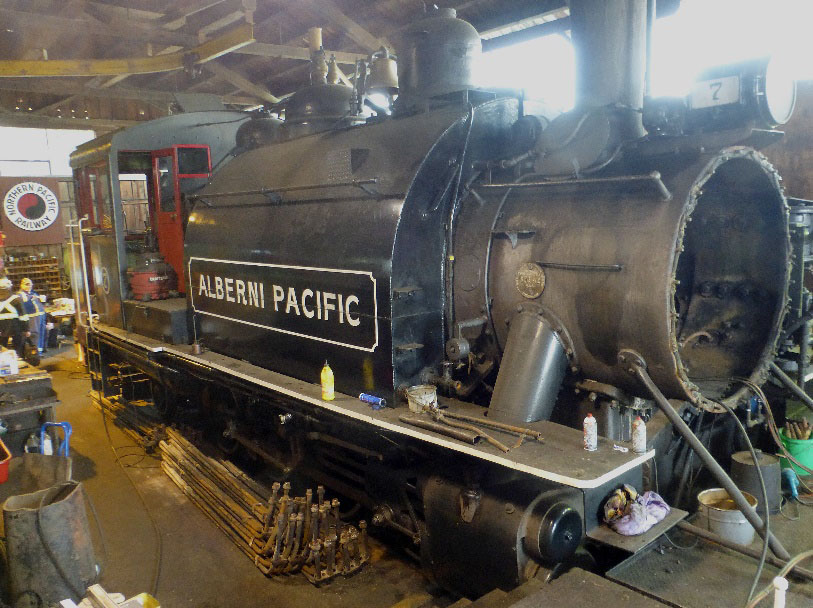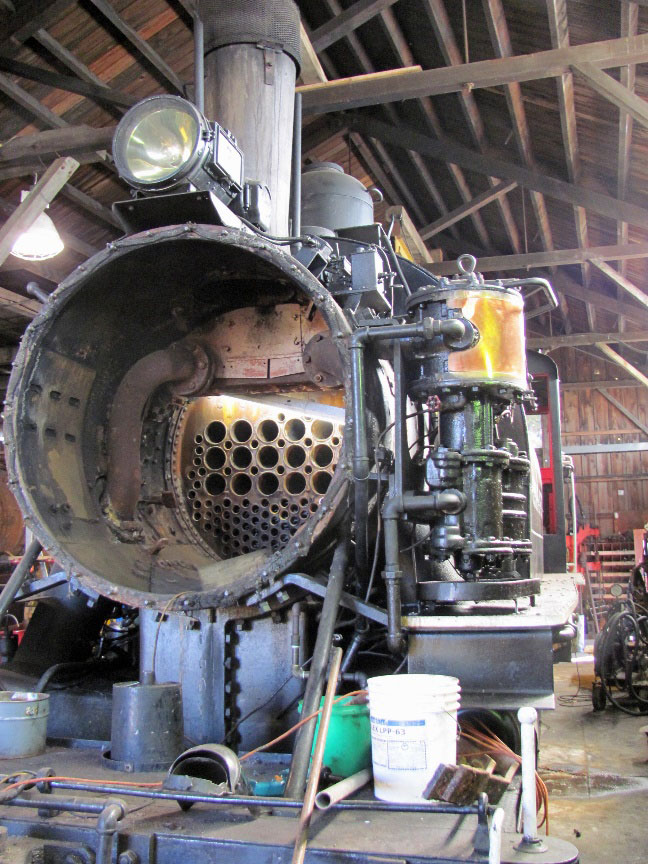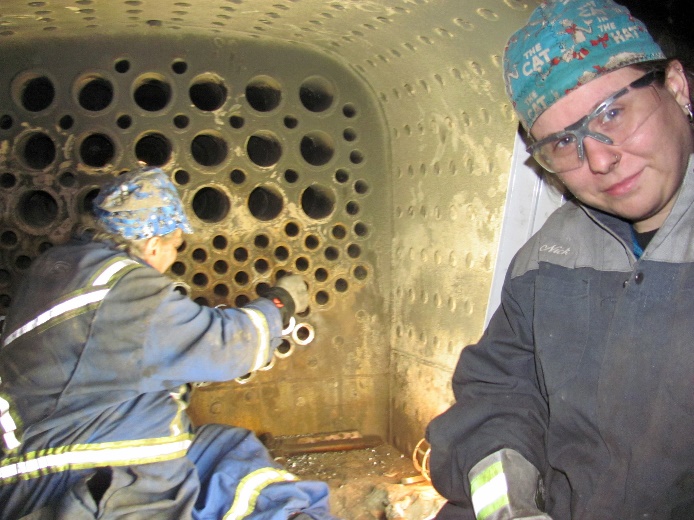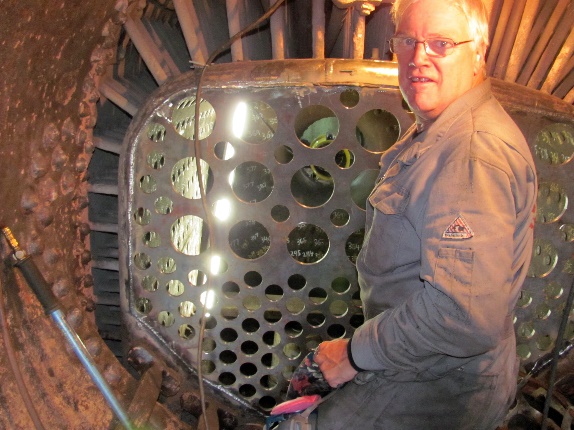
The Number 7, in the shop for repairs with the saddle water tank still installed, is owned by the City of Port Alberni and is cared for by the Western Vancouver Island Industrial Heritage Society. The shell was stripped bare to the water tank and the tubes & tube sheets for inspection. Laying on the floor next to #7 you can see the superheaters that were removed from the flue tubes that were later installed back into the boiler.
On Vancouver Island in the City of Port Alberni, British Columbia, there is a group of active & retired Lodge 359 Boilermakers using their trade skills to give back to their community. The Boilermakers are repairing a 1929 Baldwin 2-8-2T steam locomotive in a railyard that is sandwiched between the cloudy mountains of the Alberni Valley and the Pacific Ocean.
Boilermakers Barry Dobrensky, Mike Roxburgh, Brent Pennington, Sarah Smith, Carl Barnes, Barry Payne, Brent Graham, Matt Wallace, Tim Murphy and Russ Herding have all given their time to repair the Baldwin known as Number 7.
Number 7 came to Vancouver Island after it was ordered in 1928 from the Baldwin Locomotive Works in Pennsylvania along with a second locomotive, the final two steam trains designed and ordered for use in the great forests of Canada. The two locomotives were delivered to their first owner, the Campbell River Timber Company, just before the 1929 stock market crash. Number 7 was the longest operating steam locomotive serving the B.C. logging industry when she was retired from industrial service in 1972. In 1990 the Province of B.C. donated the train to the City of Port Alberni to be used as a tourist train.
The Boilermakers involvement in this project started in 2018 when the Western Vancouver Island Industrial Heritage Society (I.H.S.) contacted Boilermakers Lodge 359 looking for help in ordering tubes. Brother Barry Dobrensky spoke with I.H.S. on behalf of 359, and after a few minutes of listening to what the society was up to, Dobrensky was in and he brought along a crew. This crew of Boilermakers previously worked with I.H.S. in 2013 to restore a 1917 “Farquhar” steam tractor and a steam donkey.
Besides the skill sets of fitting, layout and welding, the Boilermakers bring their expertise in planning a project and working with the provincial safety regulators for boilers, along with their industry connections, to get the projects that I.H.S. have on the drawing board ready for public display.
Retired members and clearly not retired from the trade Brothers Dobrensky and Roxburgh have been sharing the lead in project management on the projects. Dobrensky has been doing the planning and execution as well as rounding up Boilermakers to volunteer their help. Roxburgh brings his level 2 welding inspector certification and does all the quality control requirements. He developed a complete repair plan and is working with the BC Safety Authority to produce a detailed manual with all relevant paperwork for the I.H.S. use.
David Hooper, a member and volunteer of the I.H.S., says “It blows me away with the time the Boilermakers have given to this project, they come from outside of the Valley to help us out.”
The mission to bring Number 7 back to her old glory started in 2019. The project required the removal & replacement of all the tubes and the tube sheets, removal of the saddle water tank, and opening of all hatches. The boiler had to be stripped down to the bare shell for inspection purposes. It was an onerous and dirty job removing the tubes by cutting torch, but for the Boilermakers it was just another day at the trade.
Brother Barry Dobrensky tells us the plate for the tube sheets was cut to size by using cutting torch and zip cuts, and the holes were formed by using a high-pressure water jet. There are over 100 boiler tubes with 2” OD and 21 flue tubes that have 5 1/2” OD on one end and 4 1/2” swag end on the other. Once the tube sheets were grounded & bevelled Brother Brent Graham welded them in place.
While the tubes were being stabbed and expanded, the superheaters that were installed into the flue tubes were pressure tested. Brother Dobrensky’s prediction is for a hydrostatic test at the end of February 2020, with steam up likely a couple of months after that.
The goal is to have Number 7 in operation by the summer of 2020. Updates will be posted on boilermaker.ca. The long-term goal is to bring the tourist train back to Alberni Valley for a ride that takes 35 minutes along the city’s waterfront to the historic park of Mclean Mill.
Brother Dobrensky wanted to note the volunteer work of I.H.S. members who have jumped in with help & support, along with Union Bricklayer Dave Delucry for his work on the brickwork in the smoke box.

1929 Baldwin Locomotive under repair at Port Alberni, B.C.

Sister Sarah Smith on the right with Brother Brent Pennington in the background.

Sister Sarah Smith and Brother Barry Dobrensky preparing a tube sheet to be formed in shape.

Brother Brent Graham, in the smoke box, welded the new tube sheets in place.

Brother Matt Wallace in the fire box rolling the tubes.
Background on #7
In the early 1900’s, steam power came to the forestry industry of Alberni Valley on Vancouver Island. Steam power was used to operate the mills, but to move the logs horses were used and that only works for flat land operations, so in the Alberni Valley it had limited use. To increase production of logs to the sawmills, steam trains were introduced to the logging industry in 1912. Number 7 was designed for use in the forest industry because the tracks were usually temporary. The locomotive was short and stubby with the weight centered over the drive wheels for better traction and to help keep the engine on the rails. She was built for pulling power; not for speed.
In 1954 after a severe rainstorm causing damage to the footings of a temporary bridge that was not noticed during inspection, the 90-ton locomotive crashed into the river below while crossing. The engineer and head brakeman died in the accident. The fireman fell into the river and was swept down river before he grabbed some branches to hold on to until rescue came along.
The Baldwin was rigged out of the water on her side to the shore using steam donkey lines, blocks and come-a-longs. The locomotive was hauled back to the shop where the bends and dings on the saddle tank & cab were repaired along with some mechanical damage. Number 7 was put back in service for another 18 years.
Photos supplied by David Hooper, Western Vancouver Island Heritage society.
Related Content:
